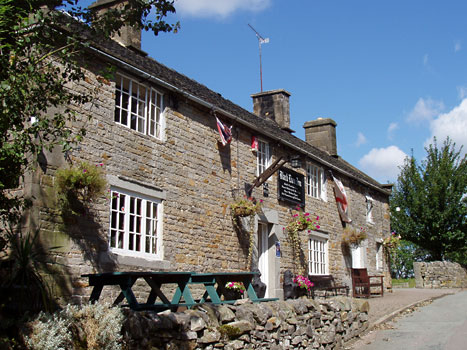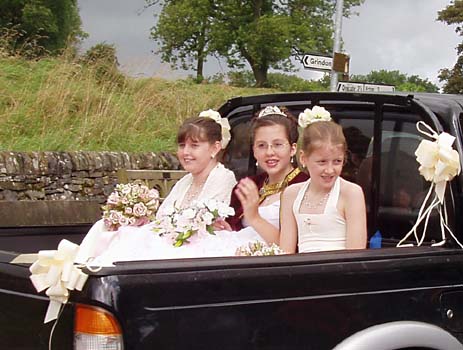 |
| St. Bartholomews, in June 2021 |
 |
| St. Bartholomews, in June 2021 |
 |
 |
|
| "Ducks playing in the river Slow" | The old school house | |
 |
 |
|
| The Black Lion | St. Bartholmew's in 2021 | |
 |
 |
|
| The font | Memorial to a local tragedy | |
 |
 |
|
| Carnival Princesses | Jolly Butterton folk |
Butterton is unusual in having a ford where the stream runs down a cobbled street. Up the steep hill beyond the ford is the old school house and the church is at the top of the hill. St. Bartholomew's was built in 1871-3 by the architect Ewan Christian. The west spire was added in 1879 by Sugden. Inside is a monument to three men who died on 30 August 1842 while trying to rescue a boy who had entered a disused mine shaft. The font is a survivial from an earlier church. The church has a separate nave and chancel but there are no choir stalls or screen.
Opposite the church is the Black Lion which has outside a curious emblem in the shape of a large clothes peg. The pub has two bars, one catering specifically for walkers. Nearby are prehistoric barrows from which have been excavated spearheads and ornaments.
In 2004, we arrived in Butterton in time for the village fete procession; it was chilly for the girls in their fine gowns but the gnomes were well prepared for the climatic rigours of an August day in the Moorlands. On my most recent visit, in 2021, I noted a sign celebrating the fact that Butterton was "Doubly Thankful Village" in that all the men who served in the two world wars came home again.
Information sheet in the church.
The King's England, Staffordshire, by Arthur Mee, Hodder and Stoughton,
London, first published in 1937.